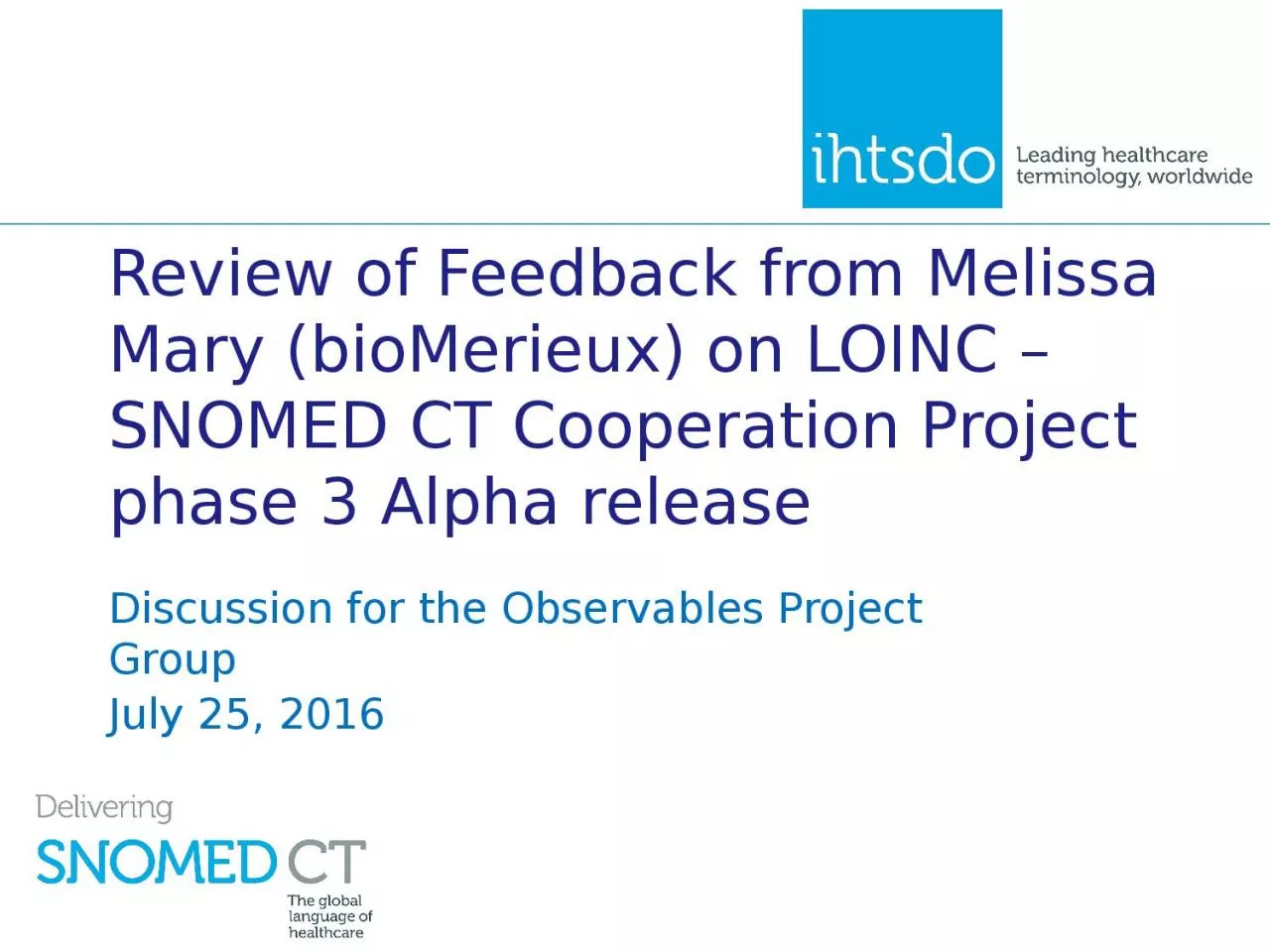

bioMerieux on LOINC SNOMED CT Cooperation Project phase 3 Alpha release Discussion for the Observables Project Group July 25 2016 Melissa Mary submitted analysis of LOINC SNOMED CT Cooperation Project phase 3 Alpha release ID: 1034858
Download Presentation The PPT/PDF document "Review of Feedback from Melissa Mary (" is the property of its rightful owner. Permission is granted to download and print the materials on this web site for personal, non-commercial use only, and to display it on your personal computer provided you do not modify the materials and that you retain all copyright notices contained in the materials. By downloading content from our website, you accept the terms of this agreement.
1. Review of Feedback from Melissa Mary (bioMerieux) on LOINC – SNOMED CT Cooperation Project phase 3 Alpha releaseDiscussion for the Observables Project Group July 25, 2016
2. Melissa Mary submitted analysis of LOINC – SNOMED CT Cooperation Project phase 3 Alpha release as feedback to IHSDO on 10 JuneMelissa Mary presented analysis of LOINC – SNOMED CT Cooperation Project phase 3 Alpha release to the Observables PG on 26 June, 2016Focus on LOINC Term classification with SNOMED CT and suitability for query and/or aggregationAnalysis of previous project alpha releases focused on LOINC Part mapping to SNOMED CT concepts and attributesFAS and SSA to comment on analysis in this presentationBackground
3. 46 LOINC Terms classified as equivalent14 result of 1 mismapping in original base file (LOINC Part to SNOMED CT concept map error)6 result of having similar bacteria identification LOINC Terms mapped similarly and designated fully defined20 result from duplication within LOINC6 result from inconsistent/unclear LOINC TermsClassification metrics – equivalent LOINC Terms
4. Example:Classification metrics – equivalent LOINC Terms: 14 Amphetamine Terms
5. These 14 equivalencies a result of 1 mismapping in original base file (LOINC Part to SNOMED CT concept map error)Previous solution determined with input from RII and Substance Team: LP COMPONENT Amphetamine mapped to 703842006 | 1-phenylpropan-2-amine (substance) and LP mapped to 703841004 | Substituted amphetamine (substance)Came up during internal review again prior to release and map was changed so both LPs map to 703842006 | 1-phenylpropan-2-amine (substance)JIRA ticket to clarify with RII – not sure of status.Action: Clarify with RII and remap as appropriate so equivalencies do not occur (JIRA tickets: LOINC-28 and LOINC-195)Classification metrics – equivalent LOINC Terms: 14 Amphetamine Terms
6. Classification metrics – equivalent LOINC Terms: 6 bacteria identification Terms
7. These 6 equivalencies a result of similar Terms being mapped the same and marked fully definedPrevious solution (2014-2015) determined with IHTSDO internal team that these should be equivalentDiscussion in April 2016 Business Meeting that these should be mapped with different techniques such as biotyping (264788002), serotyping ( 258075003), phage typing (to be created)Action: Create new typing technique concept and remap these Terms using the technique concepts so equivalencies do not occur (JIRA tickets: LOINC-160, LOINC-173, etc.)Classification metrics – equivalent LOINC Terms: 6 bacteria identification Terms
8. Examples:Classification metrics – equivalent LOINC Terms: 20 duplicate Terms
9. These 20 equivalencies are a result of duplication within LOINCHave been confirmed by RII or are being considered by RIIRII plan to deprecate most of the duplicate Parts and TermsFor the “unadjusted” Terms, RII has already marked them as discouraged and mapped them to the generic termAction: Remove duplicate Parts and Terms from project files after they are removed from LOINC (JIRA tickets: LOINC-152, LOINC-158, LOINC-149, LOINC-155)Update documentation to include these duplicates until the time they are removed from LOINCUpdate documentation to explain the status of the “unadjusted” Terms (JIRA ticket: LOINC-187)Classification metrics – equivalent LOINC Terms: 20 duplicate Terms
10. Examples:Classification metrics – equivalent LOINC Terms: 6 inconsistent/unclear Terms
11. These 6 equivalencies seem to be duplicates at first but are actually unclear Terms within LOINC that can be clarified and improvedHave been confirmed by RII or are being considered by RIIRII plan to improve existing Parts and TermsAction: Update maps for Parts and Terms in project files after the corrections are made in LOINC (JIRA tickets: LOINC-159, LOINC-117, LOINC-157)Update documentation to reference these issues until the time they are corrected in LOINCClassification metrics – equivalent LOINC Terms: 6 inconsistent/unclear Terms
12. Classification deemed consistent overall, with 3 potential errors identifiedAnalyzed two main types of inference:1. surDefinitionExample: increment of test definition of addition of information Challenge, Method, etc.Discussed in previous analysis: RII confirmed that these inferences are correctAction: Update documentation to point this outClassification metrics – subClassOf inference
13. Analyzed two main types of inference:2. subClassOf errors:Property hierarchy, e.g. log#/volume is descendant of #/volumeComponent hierarchy, see example belowAction: create JIRA tickets to track issues, discuss with relevant groups (e.g., sent to Ed. Adv. Group)Classification metrics – subClassOf inference
14. Why were Antibacterial antibody Terms included?Why were results of query with SNOMED less than with LOINC?What was the query set for LOINC (all of LOINC or just alpha release set)?Can we see the results of the query?Improvement of tests query using SNOMED CT ontology